Below is the following schedule for broadcast Masses from the Cathedral of Saint Peter in Scranton, Vatican, and Washington D.C., for the Sacred Paschal Triduum.
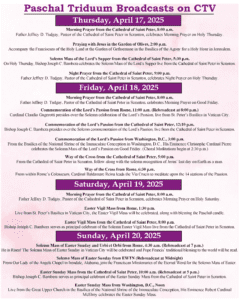

Below is the following schedule for broadcast Masses from the Cathedral of Saint Peter in Scranton, Vatican, and Washington D.C., for the Sacred Paschal Triduum.

SCRANTON – Only a slight breeze was blowing in the Cathedral Prayer Garden April 13, 2025, as the Most Rev. Joseph C. Bambera, Bishop of Scranton, began Palm Sunday Mass with a blessing of the palms, surrounded by a crowd of faithful who held branches of their own.
With palms in hand, the congregation joined the Bishop in a procession into the Cathedral of Saint Peter, reenacting Christ’s triumphant entry into Jerusalem. It was a symbolic start to Holy Week, marking the beginning of a journey that would move from celebration to the solemn remembrance of Jesus’ death.
Following the proclamation of the Passion from the Gospel of Luke, Bishop Bambera invited the faithful deeper – beyond the palm branches – into the very heart of the Cross.
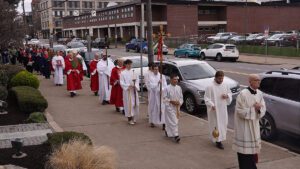
The Bishop opened his homily with a historical reflection: the story of Emperor Heraclius, who, in the 7th century, recaptured the relic of the True Cross of Christ from Persia and sought to return it to Jerusalem’s Church of the Holy Sepulcher.
Clothed in royal splendor – gold and jewels – Heraclius found himself unable to move forward through the gates of Calvary. It wasn’t until he removed his lavish garments that he could carry the relic to its rightful place.
Drawing from the writings of Cardinal Raniero Cantalamessa, longtime preacher to the papal household, the Bishop then reminded the faithful that none of us can approach the Cross while clinging to pride or self-importance.
“We cannot possibly draw near to the crucifix unless we first get rid of our pretensions to greatness, to our rights, and, in other words, to our pride and vanity,” the Bishop quoted. “It is simply not possible. We would be invisibly rejected.”
Just as the celebrant removes his shoes and vestments before venerating the Cross on Good Friday, so too must every Christian spiritually strip away the layers of ego and self-reliance.
“Only when we are finally humble enough to admit that we cannot save ourselves,” the Bishop said, “will there be space in our hearts for the love of Jesus – a love that alone has the power to carry us to a place of life and peace.”
As Holy Week begins, Bishop Bambera urged the faithful to not simply observe the coming days but enter fully into them.
“For all that we bring (to Holy Week), may we not forget to enter these sacred days praying for the same spirit of humility that characterized Jesus’ life and His embrace of the Cross.”
FREELAND – As spring flowers blossom and Easter draws near, volunteers at Our Lady of the Immaculate Conception Parish have been remarkably busy.
Parish volunteers recently assembled dozens of “forget-me-not” gift bags for elderly and homebound parishioners. On Saturday, April 12, the bags, along with Easter lilies and palms, were delivered to nursing homes and residences.
“When we deliver the bags and lilies, we receive a lot of very positive feedback from the parishioners. They’re extremely grateful,” John Chuckra, chairperson of the parish community service team, said. “A common comment is ‘my parish family always remembers me’ and that is very, very great to hear.”
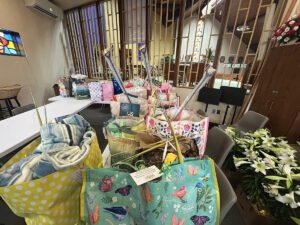
Tucked inside the thoughtfully prepared bags are more than just essentials – they also contain lotions, hand creams, stamps, warm blankets, and puzzles that are all carefully selected by parishioners.
Each bag is, in truth, a vessel of love, and a message of remembrance sent to the senior members of the parish.
“We are very concerned with letting them know that they are treasures of the past and this program goes hand-in-hand with an ‘Hour of Kindness’ where we meet every month, the last Saturday of the month, and we sign and address greeting cards for our elderly,” parish secretary Janet Croshaw explained. “Every month, instead of a bill or junk mail, they also get a lovely message, a lovely greeting card from their parish family, reminding them that they have not been forgotten.”
Croshaw and a small team spearhead the special ministry. They say it began after realizing the parish does a lot of children – like collecting coats and backpacks – but wanted to also do something for its eldest members.
“My mom was in a nursing home, and they would come, and she enjoyed getting that bag of goodies. She called it her bag of goodies. She really enjoyed it,” volunteer Sharon Yefchak said. “It’s good for us as a parish to reach out to people. It makes you feel good, and it makes them feel good.”
Parishioner Cheryl Turri not only helps assemble the “forget-me-not” bags but also helps to deliver them.
“One of the ladies is 97 and she just loves this. She loves the cards she gets, the pictures, because sometimes we’ll send pictures with the cards,” Turri stated. “The whole congregation can take part in this beautiful idea.”
This outreach effort has become a lifeline, especially for those who can no longer attend Mass in person. Volunteers not only deliver the bags door to door, often staying to chat, pray, or simply sit in silence. For some recipients, these visits are a rare and treasured connection to the church community they so dearly love.
“I get a lot of pleasure doing this,” volunteer Sally Shupp said.
Shupp began helping with the distribution in memory of her mother and father. Shupp, a retired nurse, had a mother who lived in a nursing home and knows that there are many residents that don’t get visitors.
“There was just such a want of being remembered, wanting to be complimented, anything that gave them another human connection,” she explained.
In the simple act of giving – a lily, a blanket, a prayer – the “forget-me-not” bags have become a radiant sign of Easter hope for so many at Our Lady of the Immaculate Conception Parish.
“I’m hoping that they know that they’re not forgotten. We do think of them, and we pray for them,” Yefchak said.
SCRANTON – The Diocese of Scranton is proud to announce the results of its fourth annual Rectory, Set, Cook! competition – and this year’s event was one for the record books.
Between March 4 and April 10, the popular fundraising competition brought together 32 priests from across the Diocese of Scranton in a spirited battle for culinary glory – all in support of anti-hunger and anti-homelessness initiatives through Catholic Social Services.
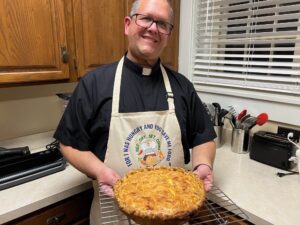
In a thrilling finale that came down to the wire, with last-minute donations tipping the scales, this year’s event raised $227,162, setting a record amount raised in the competition’s history.
“This year’s Rectory, Set, Cook! was the most exciting yet,” event director Sandra Snyder said. “I love this project because it really unites people and priests in such a special – and fun – way. It’s so inspiring to see so many pastor chefs willing to put themselves out there like this for the greater good.”
This year’s competition came down to the very last minute and a single time-stamped donation at 4:59 p.m. that made the difference between first and second place.
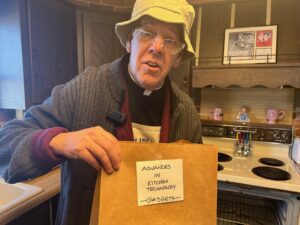
“While the competition is all in good fun, the real winners are the people whose lives will benefit from the outpouring of generosity that we see from the community,” Snyder added.
At the close of the competition at 5 p.m. on April 10, 2025, the following six teams had raised the most money and have been named the “2025 Top Chefs.”
“I believe Rectory, Set, Cook! embodies the true meaning of the Lenten season. Our faith calls us to prayer, fasting, and almsgiving and what better way to do our almsgiving during Lent than through this event,” Father Simchock said. “Not only are we feeding the hungry and sheltering the homeless, but we are also helping out our parishes that need money to get projects done around the parish.”
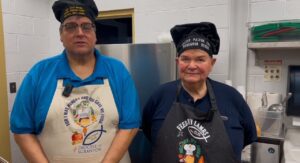
“In spite of all that is going on with our economy these days, there was not a single person approached who did not gladly and generously make a donation to this year’s Rectory, Set, Cook! campaign,” Father Paisley added. “I could not be more grateful to the 255 donors who helped me reach and surpass a personal goal of $100,000 raised since the inception of Rectory, Set, Cook! May God bless all who contributed to this fight against hunger and homelessness.”
In its inaugural year, 2022, Rectory, Set, Cook! brought in $171,747. In 2023, the online culinary competition raised a total of $197,412 and in 2024 it raised $218,001.
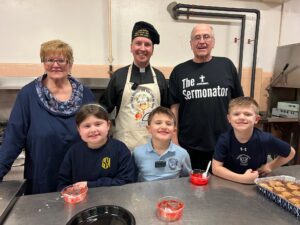
A number of community businesses help to sponsor Rectory, Set, Cook!, including the program’s presenting sponsor, Hawk Family Foundation. All sponsorship dollars raised stay directly with Catholic Social Services to benefit area kitchens, food and clothing pantries, and emergency shelters.
Catholic Social Services will use the money raised to respond to an increasing need for services in the community.
“In January, we officially opened our new, permanent home for Mother Teresa’s Haven in the city of Wilkes-Barre. After years of planning and months of construction, we are now serving our brothers in need every night in a new, modern facility, and better coordinating services with Saint Vincent de Paul Kitchen, which is now directly below the shelter,” Joe Mahoney, Chief Executive Officer of Catholic Social Services, explained. “We are so thankful for the tremendous support of everyone who donated to this year’s competition because the funding allows us to continue serving our local communities in many different and varied ways.”
SCRANTON – The Most Rev. Joseph C. Bambera, Bishop of Scranton, celebrated a Healing Mass for Survivors of Sexual Abuse at the Cathedral of Saint Peter on April 10, 2025.
“We lift them up to the Lord in prayer and we pray for God’s mercy and presence within their lives,” Bishop Bambera said.
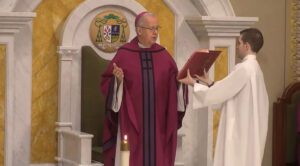
This is the seventh straight year that the Bishop has celebrated a Mass during the month of April, recognized as the month of child abuse prevention. The Bishop apologized for the pain that has been inflicted on “far too many” people and asked for their forgiveness.
“Those who have experienced abuse understand the Cross of Jesus far more than most of us,” the Bishop added. “May they, and each of us, come to understand that in uniting our Crosses with Jesus, we’re promised the blessing of His unconditional love.”
In ending the Mass, Bishop Bambera stressed we “must never forget or allow time to numb us to the pain that was inflicted on innocent lives.”
SCRANTON – From volunteering as altar servers and lectors, to serving as religious education teachers, and assisting at parish festivals, the young adults of our community make a profound difference through their service.
This year, more than 500 students in 8th and 12th grades were honored with the Bishop’s Youth Award during three special Masses held on consecutive Sundays in Lent.
Each Mass filled the Cathedral of Saint Peter to capacity as family and friends gathered to celebrate the outstanding contributions of these dedicated young people.
“It truly just demonstrates how many extraordinary young kids there are that demonstrate their faith very well,” Sienna Simmons, an eighth-grade award recipient from Saint Peter Parish in Wellsboro, said.
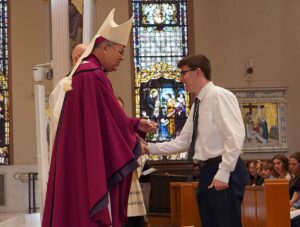
Since 1996, the Bishop’s Youth Award has been presented to students who have demonstrated exceptional dedication to their faith through volunteer service in their parish, Catholic school, or community.
“It’s a great honor to be here today to be recognized by the church and by the diocese as a hard-working young individual that likes to take part in their parish community,” A.J. Piestrak, a twelfth-grade award recipient from Holy Cross Parish in Olyphant, added.
The Most Rev. Joseph C. Bambera, Bishop of Scranton, presided over all three Masses, and took the opportunity on each occasion to express his gratitude to the recipients.
“We honor and recognize these young men and women for their commitment to live their faith and to respond to the invitation that the Lord Jesus gives to us all to walk as His disciples, to serve one another, and to provide hope to our world,” Bishop Bambera said.
During each Mass, the homily was given by a priest currently serving a parish in that region.
During the first Mass on March 23 for the eastern and western regions of the Diocese, Father Thomas Augustine, Administrator Pro Tem, Saint Brigid Parish, Friendsville, spoke about life being a journey.
“You are not walking alone. You are walking with Jesus. He is walking with you,” Father Augustine said. “The love of God, the power of God, as long as it’s with you, you’ll never lose anything. God always will be with you, and he will give you every grace to find true success.”
During the second Mass on March 30 for the southern region of the Diocese, Father Philbert Takyi-Nketiah, Administrator, Holy Spirit Parish, Mocanaqua, called on the students to be ambassadors for Christ.
“Each of you, in your actions, your ways, in your choices, have the responsibility to reflect God’s love, God’s compassion, and truth to the world around you,” Father Philbert stated.
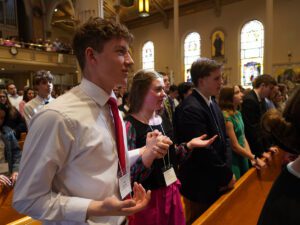
During the final Mass on April 6 for the northern region of the Diocese, Father Cyril Edwards, Pastor, Mary, Mother of God Parish, Scranton, told the award recipients they were selected for the honor because they were getting to know Jesus.
“We have great hope that you will continue to build our church, live our faith, and want to be close to Jesus,” Father Edwards explained.
Many awardees expressed how their volunteer work has strengthened their connection to the Church.
Damien Fox, a 12th-grade recipient from Queen of the Apostles Parish in Avoca, spoke about his role as a lector and volunteer with religious education. “It helps me connect with the people in my parish,” Fox said. “The people in your church are your family. You may not be blood-related, but you are family.”
As each Mass concluded, Bishop Bambera offered a final word of encouragement, urging them to continue serving their community, loving one another, and “being witnesses of Jesus Christ in all that you do.”
Ella Carroll, a 12th-grade recipient from Saint Joseph Parish in Matamoras, took those words to heart.
“God is always the answer to the issues that you’re having. Practicing your faith as a young person will help you develop and use that faith in your future as an adult,” the Pike County teenager said.
VATICAN CITY (CNS) – Especially in a Jubilee Year, but also every day, priests are called to continual conversion so that they can authentically preach the good news of hope, Pope Francis wrote in the homily he prepared for the Holy Thursday chrism Mass.
“It is God’s work, not ours: to bring good news to the poor, freedom to prisoners, sight to the blind and freedom to the oppressed,” the pope wrote in his text for the Mass April 17 in St. Peter’s Basilica.
Cardinal Domenico Calcagno, retired president of the Administration of the Patrimony of the Holy See, presided over the Mass and read the homily prepared by Pope Francis, who is still recovering from respiratory infections.
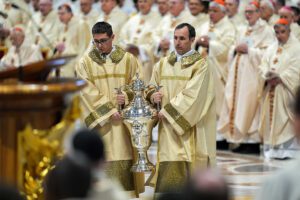
Some 40 cardinals, 40 bishops and 1,800 priests concelebrated the chrism Mass, which is named after the olive oil mixed with balsam that is blessed during the liturgy.
In the homily Pope Francis prepared, he focused on the connection between the Holy Year 2025 and the Gospel reading, Luke 4:16-21, which recounts how Jesus went into the synagogue in Nazareth, opened the Scriptures and read a “jubilee” proclamation:
“The Spirit of the Lord is upon me, because he has anointed me to bring glad tidings to the poor. He has sent me to proclaim liberty to captives and recovery of sight to the blind, to let the oppressed go free, and to proclaim a year acceptable to the Lord.”
As ministers of Christ’s continued presence, Pope Francis wrote that “for us priests, the Jubilee Year thus represents a specific summons to a new beginning on our path of conversion. As pilgrims of hope, we are called to leave clericalism behind and to become heralds of hope.”
The words of Jesus, he said, must become a reality in the lives of those who are ordained for service.
“The poor before all others, children, adolescents, women, but also any who have been hurt in their experience of the church — all these have a ‘feel’ for the presence of the Holy Spirit; they can distinguish him from worldly spirits, they recognize him in the convergence of what we say and what we do,” the pope wrote.
Ordained ministry involves effort and, often enough, priests will not see the results of their labors, Pope Francis wrote. But “despair has no place.”
“Every farmer knows seasons when nothing seems to grow,” his text said. “There are also times like these in our lives. It is God who gives the growth and who anoints his servants with the oil of gladness.”
After the homily, the clergy present renewed the promises made to their bishop at their ordinations and pledged to strive to be more united to Christ, “faithful stewards” of the sacraments and zealous pastors of souls.
Deacons then wheeled large silver urns of oil down the center aisle of St. Peter’s Basilica to be blessed by Cardinal Calcagno. The blessed oils will be distributed to Rome parishes and used for the sacraments of baptism, confirmation, ordination and the anointing of the sick in the coming year.
VATICAN CITY (CNS) – A new bronze sculpture installed in St. Peter’s Square, near the showers and medical clinic the Vatican runs for people in need, invites visitors to reflect on the sacredness of welcoming others, especially the marginalized.
Titled “Be Welcoming,” the work by Canadian artist Timothy Schmalz was unveiled April 15 in its place on the steps leading into the square from the colonnade.
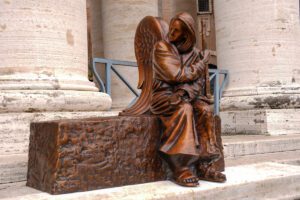
Inspired by Hebrews 13:2 — “Do not neglect hospitality, for through it some have unknowingly entertained angels” — the sculpture depicts a weary traveler appearing as a homeless man. However, from another angle, his tattered belongings transform into angelic wings.
The statue aims to make Scripture tangible by offering a “physical experience” of the biblical text, said a press release April 15 from the office of the papal almoner.
Schmalz is also known for “Angels Unaware,” a sculpture depicting migrants from various historic periods and ethnic groups, that stands on the opposite side of St. Peter’s Square.
VATICAN CITY (CNS) – Pope Francis is going without supplemental oxygen for longer periods and is continuing therapy to recover his voice and to recover his physical strength, the Vatican press office said, but he also is increasing the number of private meetings he is holding with the heads of Vatican offices.
Briefing reporters April 15, Tuesday of Holy Week, the most liturgically significant and busy week of the year, the Vatican press office did not say if Pope Francis would attend any of the liturgies, but it announced the names of the cardinals delegated by the pope to preside over the chrism Mass on Holy Thursday, the Liturgy of the Lord’s Passion April 18 and the Way of the Cross at Rome’s Colosseum that night.
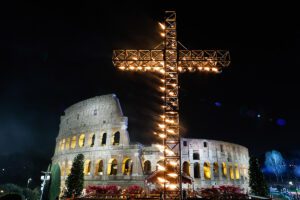
The pope asked Italian Cardinal Domenico Calcagno, retired president of the Administration of the Patrimony of the Holy See, to lead the morning chrism Mass April 17. While the parish of St. Peter’s Basilica has its own Holy Thursday Mass of the Lord’s Supper, the pope usually celebrates the evening Mass with the foot-washing rite “privately” at a prison or detention facility; the press office said it had no information about what the pope would do this year.
Cardinal Claudio Gugerotti, prefect of the Dicastery for Eastern Churches, was chosen by the pope to lead the Good Friday liturgy in St. Peter’s Basilica. The Vatican’s long custom is that the preacher of the papal household, now Capuchin Father Roberto Pasolini, preaches at the liturgy.
Pope Francis asked Cardinal Baldassare Reina, his vicar for the Diocese of Rome, to lead the Via Crucis at the Colosseum that night. Pope Francis prepared the text of the meditations, the press office said.
The 88-year-old pope, who was released from Rome’s Gemelli hospital March 23 after 38 days of treatment, spent two weeks in his rooms in the Domus Sanctae Marthae before making any public appearances. Then he arrived briefly at the end of Masses in St. Peter’s Square April 6 and April 13, visited St. Peter’s Basilica April 10 and the Basilica of St. Mary Major April 12.
(OSV News) – Catholic leaders and public officials condemned violence and called for peace after an alleged arson attack on the Pennsylvania governor’s mansion in Harrisburg, Pennsylvania.
In a statement, Bishop Timothy C. Senior of Harrisburg called the attack a “heinous act” that “struck at the very heart of our shared values as a society.”
Pennsylvania law enforcement officials arrested and charged Cody Balmer of Harrisburg with attempted murder, arson and terrorism, after they said he scaled an iron security fence surrounding the governor’s official residence in the middle of the night, eluded police officers and broke into the mansion, where he set a fire.
In a social media post, Gov. Shapiro said he and his family were awakened early in the morning of April 13 to “bangs on the door from the Pennsylvania State Police after an arsonist set fire to the Governor’s Residence in Harrisburg.”
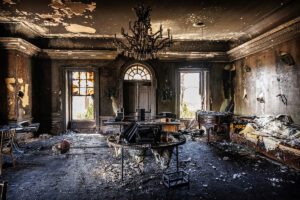
“The Harrisburg Bureau of Fire was on the scene and while they worked to put out the fire, we were evacuated from the Residence safely by Pennsylvania State Police and assisted by Capitol Police,” he wrote. “Thank God no one was injured and the fire was extinguished.”
“Every day, we stand with the law enforcement and first responders who run towards danger to protect our communities,” he said, adding he and his wife, Lori, “are eternally grateful to them for keeping us safe.”
Law enforcement authorities found two broken glass beer bottles that had been filled with gasoline they believe Balmer used to start the fire, they said.
Pennsylvania State Police said the fire caused a “significant amount of damage to a portion of the residence.” Photos released by the Pennsylvania state government showed damage to multiple rooms, art, a piano and furniture.
Shapiro, who is seen as likely to seek his party’s nomination for president in 2028, also oversaw the law enforcement response to the assassination attempt against President Donald Trump in Butler, Pennsylvania, last year, when the former president and Republican nominee for 2024 held a campaign rally.
“This type of violence is not OK,” Shapiro said at a press conference April 13 at the residence. “This kind of violence is becoming far too common in our society. I don’t give a damn if it’s coming from one particular side or the other, directed at one particular party or another, one particular person or another, it is not okay, and it has to stop. We have to be better than this.”
In his statement, Bishop Senior said, “I want to unequivocally state that all forms of hate are unacceptable. They have no place in our hearts, our homes, or our communities. Such acts of violence and intolerance threaten the fabric of our society and undermine the principles of love, respect, and understanding that all people of faith are called to embody.”
Authorities have not yet made a motive for the attack public. Shapiro, who is Jewish, had celebrated Passover the evening prior to the incident, according to a post he wrote on X.
“As Catholics, we must be committed to the eradication of any form of hatred, including antisemitism,” Bishop Senior said. “I am saddened that any form of political violence, let alone violence that is motivated by an attempt to suppress or intimidate a family because of their religion, is found in our community — especially at this time that is so sacred to our Jewish brothers and sisters and also to all of us as Christians as we celebrate Holy Week.”
“Our prayers are with the Shapiro family and their guests, whose faithful observance of the sacred tradition of their faith was grievously violated by this act,” he added. “We Christians must stand in solidarity with our Jewish brothers and sisters in all circumstances, but especially this year as the observance of the days of Passover coincides with the most sacred days of the Christian Liturgical calendar, Holy Week, the week leading us to our Easter celebration.”
“I call on all our Catholic faithful in the Diocese once again to be men and women of communion. Extend a hand of friendship and solidarity to those whose faith tradition, race or ethnicity is different from our own. Together, we can stand against hate and create an environment where love and acceptance thrive and the God-given dignity of every person is respected,” Bishop Senior said. “As we pray for the Shapiro family and all those affected by this incident, let us also pray for the courage to confront hate in all its forms. May our actions reflect the love that binds us together and may we be instruments of peace in a world that desperately needs it.”
“We must be deeply grateful that Governor (Josh) Shapiro and his family are safe, and we must also pray for an end to violence, which goes against everything good about us as human beings,” Bishop David A. Zubik of Pittsburgh said in a statement April 13.
Bishop Zubik said that “we should all be shocked at the reported act of arson at the residence of Governor Josh Shapiro and his family. Particularly during this Holy Week for Christians and Passover time for the Jewish people, we focus on the deep love that God has for all of us.”
Pennsylvania Sens. Dave McCormick, a Republican, and John Fetterman, a Democrat, both condemned the violence.
“The horrific attack against (Shapiro) and his family is terrible,” McCormick wrote on X. “This type of violence cannot be tolerated and the criminals responsible must be prosecuted for these deplorable actions.”
Fetterman called the attack “truly appalling.”
“Profoundly grateful that (Shapiro) and his family are unharmed, and grateful for the police and first responders for their quick actions,” he said. “Whoever did this must be held to the fullest extent of the law.”
Trump administration officials, including Attorney General Pam Bondi and Vice President JD Vance.
“I am deeply relieved that Governor Shapiro and his family are safe, thankful for the first responders who arrived on the scene, and applaud the police work that resulted in an arrest just hours ago,” Bondi wrote on X.
Vance expressed gratitude the Shapiro family was safe in a post on X and called the incident “really disgusting violence,” adding, “I hope whoever did it is brought swiftly to justice.”